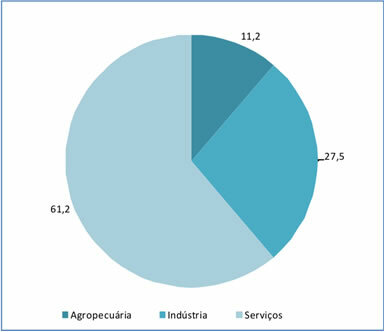Portuguese, German and Italian immigrants played an important role in strengthening the state economy. They developed cultivation techniques in the region, in addition to promoting economic development in Rio Grande do Sul. The evolution of the state economy occurred satisfactorily and, currently, the state has the fourth largest economy in the country, second only to the states of São Paulo, Rio de Janeiro and Minas Gerais. Follow the progression of the state's Gross Domestic Product (GDP) in the period from 2002 to 2009:
2002: 105.4 million reais
2003: 124.5 million reais
2004: 137.8 million reais
2005: 144.2 million reais
2006: 156.8 million reais
2007: 176.6 million reais
2008: 192.8 million reais
2009: 202.9 million reais
The Gaucho GDP has shown significant changes every year. Currently, it represents 6.4% of the national GDP, and at the regional level this share is approximately 40%. Its composition is as follows:

Composition of Rio Grande do Sul's GDP
Therefore, the service sector is the main segment of the state economy (61.2%), standing out, mainly, in Porto Alegre, capital of the state.
Industry, responsible for 27.5% of the state's GDP, is well diversified and developed from agribusiness and other segments linked to the primary sector. The industries of transformation, food, petrochemicals, machinery, automobiles (General Motors), agricultural implements, fertilizers and shoes stand out.
Do not stop now... There's more after the advertising ;)
Agriculture, despite contributing directly with only 11.2% to the GDP of Rio Grande do Sul, is a fundamental activity. importance for the state economy, as it is through it that various segments of industry and services are derived.
The state stands out for being the third largest national producer of grains, being only inferior to the states of Mato Grosso and Paraná, with an expressive harvest of rice, soy, corn, wheat, cassava and grape. It also has one of the largest cattle herds in the country and the second largest poultry breeding.
Data on the economy of Rio Grande do Sul:
- Gross Domestic Product (GDP): 176.6 billion reais
- GDP per capita: 18,777 reais
- Exports – 18.3 billion dollars:
Soybeans and derivatives: 16%
Meat: 12%
Smoke: 10%
Automotive vehicles: 8%
Machines and equipment: 8%.
Footwear: 7%
Drilling and exploration platforms: 5%
Plastic and its products: 4%
Others: 30%
- Import - 14.5 billion dollars:
Oil: 30%
Automotive vehicles and parts: 13%
Fertilizers and fertilizers: 12%
Machines and equipment: 10%
Petroleum derivatives: 9%
Products from chemical industries: 7%
Food: 3%
Others: 16%
By Wagner de Cerqueira and Francisco
Graduated in Geography
Brazil School Team
Rio Grande do Sul - South region
geography of Brazil - Brazil School
Would you like to reference this text in a school or academic work? Look:
FRANCISCO, Wagner de Cerqueira e. "Economy of Rio Grande do Sul"; Brazil School. Available in: https://brasilescola.uol.com.br/brasil/economia-rio-grande-sul.htm. Accessed on June 28, 2021.
